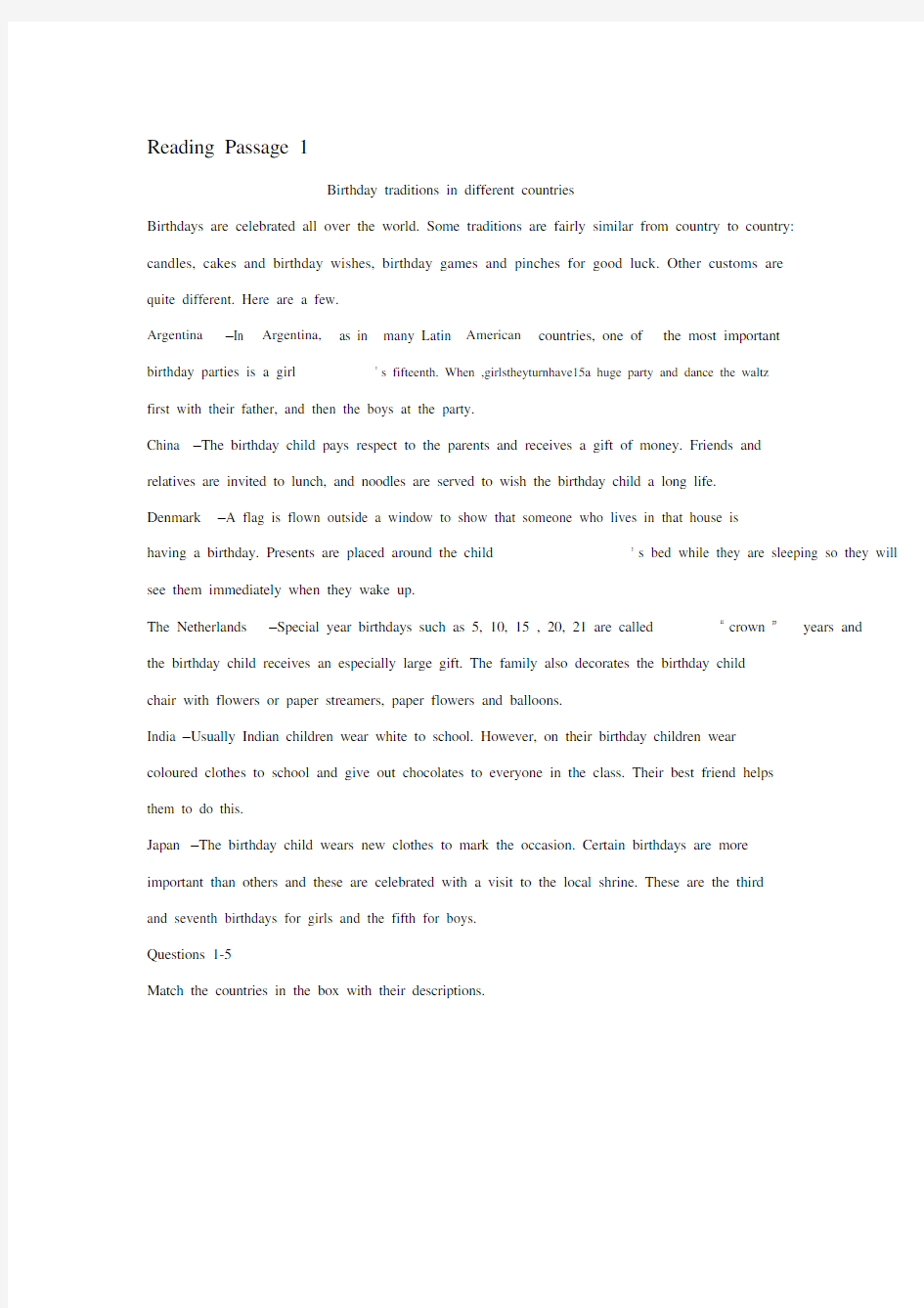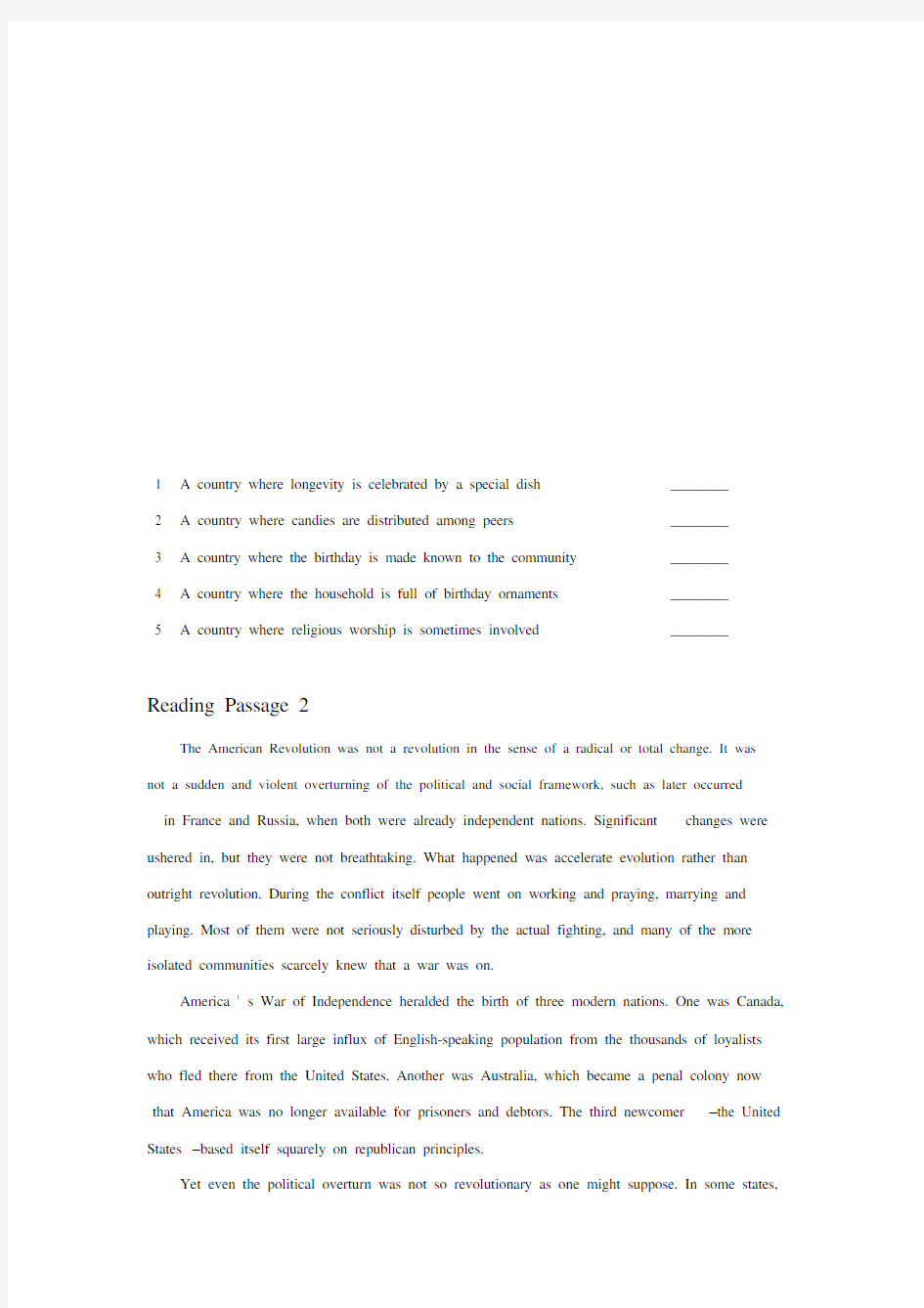雅思基础阅读.doc


Reading Passage 1
Birthday traditions in different countries
Birthdays are celebrated all over the world. Some traditions are fairly similar from country to country:
candles, cakes and birthday wishes, birthday games and pinches for good luck. Other customs are
quite different. Here are a few.
Argentina –In Argentina, as in many Latin American countries, one of the most important
birthday parties is a girl’ s fifteenth. When ,girlstheyturnhave15a huge party and dance the waltz
first with their father, and then the boys at the party.
China –The birthday child pays respect to the parents and receives a gift of money. Friends and
relatives are invited to lunch, and noodles are served to wish the birthday child a long life.
Denmark–A flag is flown outside a window to show that someone who lives in that house is
’ s bed while they are sleeping so they will having a birthday. Presents are placed around the child
see them immediately when they wake up.
The Netherlands–Special year birthdays such as 5, 10, 15 , 20, 21 are called“ crown”years and
the birthday child receives an especially large gift. The family also decorates the birthday child
chair with flowers or paper streamers, paper flowers and balloons.
India –Usually Indian children wear white to school. However, on their birthday children wear
coloured clothes to school and give out chocolates to everyone in the class. Their best friend helps
them to do this.
Japan –The birthday child wears new clothes to mark the occasion. Certain birthdays are more
important than others and these are celebrated with a visit to the local shrine. These are the third
and seventh birthdays for girls and the fifth for boys.
Questions 1-5
Match the countries in the box with their descriptions.
1 A country where longevity is celebrated by a special dish ________
2 A country where candies are distributed among peers ________
3 A country where the birthday is made known to the community ________
4 A country where the household is full of birthday ornaments ________
5 A country where religious worship is sometimes involved ________
Reading Passage 2
The American Revolution was not a revolution in the sense of a radical or total change. It was
not a sudden and violent overturning of the political and social framework, such as later occurred in France and Russia, when both were already independent nations. Significant changes were ushered in, but they were not breathtaking. What happened was accelerate evolution rather than outright revolution. During the conflict itself people went on working and praying, marrying and playing. Most of them were not seriously disturbed by the actual fighting, and many of the more isolated communities scarcely knew that a war was on.
America ’ s War of Independence heralded the birth of three modern nations. One was Canada, which received its first large influx of English-speaking population from the thousands of loyalists who fled there from the United States. Another was Australia, which became a penal colony now that America was no longer available for prisoners and debtors. The third newcomer–the United States –based itself squarely on republican principles.
Yet even the political overturn was not so revolutionary as one might suppose. In some states,
notably Connecticut and Rhode Island, the war largely ratified a colonial self-rule already existing.
British officials, everywhere ousted, were replaced by a home-grown governing class, which
promptly sought a local substitute for king and Parliament.
Questions 6-10
6.Which of the following would be the best title for the passage?
A The United States: An Isolated Community
B Breathtaking Events During the American Revolution
C Canada and the American War of Independence
D The American Revolution: Evolution Not Revolution
7.In the first paragraph, what does the author suggest about the French and Russian Revolutions?
A They were explosive and abrupt.
B They were ineffective.
C They involved only those people living in urban areas.
D They led to the release of all political prisoners.
8. In line 5, what does the author mean by“ people went on working and praying, marrying and praying”?
A More people got married than divorced.
B The war created new jobs.
C Life went on as usual.
D People had more than enough leisure time.
9.In the second paragraph, the author states that the colonies struggle’ for self -government
preceded the creation of all of the following countries EXCEPT
A Canada
B The United States
C Australia
D The United Kingdom
10.It can be inferred from the passage that the loyalists who escaped to Canada were
A Russian
B French
C British
D Australian
Reading Passage 3
Puffery in Advertising
A “ Our coffee is loved by millions worldwide. ” Do you often see this kind of advertising in your country? Statements like these, that no-one can prove, are called puffery This is a term that has
been developed for exaggerated claims that are made in advertising. Puffery is legal, even though
such claims cannot be proved. In fact, puffery has been termed “ a licence to lie ” , as it is v enough to be classed as opinion, an expression of the salesperson's evaluation of the product,
rather than an objective statement.
B Using puffery to raise awareness of products and to generate increased sales is a common
advertising strategy. Goods and services are described in terms of superlatives, subjective opinions
and exaggerations; various kinds of general claims are made, with no specific facts. So, why do
some people worry about puffery? One of the concerns is whether consumers are misled by false
advertising. Legal guidelines and government controls are required to prevent dishonest
advertising. Companies understandably object to untruthful ads which give a competitor an unfair
advantage in the market. These claims can be tested in the courts, and the decisions that are made
help to make the boundary between acceptable puffery and illegal advertising.
C Puffery is nothing new. It has been identified in documents dating from as long ago as the
sixteenth century, when the notion of “ caveatemptor ”or “ letthe buyer beware ”developed in
business transactions. Although this initially applied to property deals, it came to be used more
generally. This Latin term basically meant that anyone buying a product had a responsibility to
check it carefully before payment. The seller did not need to take responsibility for defects (unless
a problem had been deliberately concealed). In those days, of course, there was no notion of
consumer rights or returns policies.
D These days, however, if a company claims to sell the country's “ best-loved ”or “ favourite ” product,
whether a brand of coffee or a make of car, this is held to be puffery, rather than an objective claim of
market share. Similarly, the company does not have to produce proof that this
claim is actually backed up by numbers or facts. In other words, claims such as“ the world'
cup of coffee” are impossible to prove. They are also so exaggerated that it is expected that any
consumer will understand how subjective they are. In effect, the company in question is said to be
“ boasting rather” than making objective claims. The claims are therefore not considered to be
deceptive. In fact, puffery is often considered to add to the entertainment value of advertisements,
especially television commercials.
E On the other hand, a company that states their product is the “ safest ” or“ cheapest”show proof, because these claims can directly affect their competitors. Statements that are
objective need to be backed up by proof or statistics, as consumer rights organisations can run
tests to compare products such as washing machines and vacuum cleaners. They also investigate
companies involved in insurance, finance, property, credit cards and other such services.
Companies and salespeople should therefore be very careful when making factual statements
about a product, or assertions regarding the quality of goods and services. In most developed
countries, there is likely to be an official organisation which oversees the validity of advertising
claims. In addition, there may be a government council with the authority to take legal action
against companies that overstep the limit.
F A primary function of advertising is to create product awareness. As consumers, we need to
know about competing products, so we can make informed decisions on which one to buy. While
it is important that advertisers are monitored to ensure they do not mislead consumers, it can be
argued that puffery is a good technique for raising awareness of new products that otherwise
would go unnoticed in a crowded market. As long as there are effective ways of monitoring the
claims of advertisers, to prevent deliberate deception in terms of safety or particular aspects of
performance, it seems that most puffery is relatively harmless. Rather, it should be seen as an
integral part of advertising, which most consumers can detect and laugh at rather than being
misled.
Questions 11-16
The reading passage has six paragraphs, A-E Choose the correct heading for each
paragraph from the list of headings below. Write the correct number, i-vii, next to the appropriate
paragraph. There are more headings than paragraphs.
List of Headings
i. History of Puffery
ii.Checks on Deceptive Advertising
iii.Examples of Companies Guilty of Deceptive Advertising
iv.Reasons for Monitoring Advertising
v.Summary of Role of Puffery in Advertising
vi.Definition of Puffery
vii.Puffery that is Acceptable
11)Paragraph A
12)Paragraph B
13)Paragraph C
14)Paragraph D
15)Paragraph E
16)Paragraph F
Do the following statements agree with the information given in the reading passage? Write TRUE if the statement agrees with the information
FALSE if the statement contradicts the information
NOT GIVEN if there is no information on this
17.______ Some people argue against puffery because buyers might believe everything
in advertising.
18.______ A court case is a way of determining whether advertising is deceptive or not.
19.______ Puffery dates from the days of television commercials.
20.______ ‘ Caveat emptor' means that the seller has a responsibility for any problems with
the item sold
21.______ ‘ The world's best coffee' anis example of puffery
22.______ ‘ The world's safest chainsaw' is an example of puffery.
23.______ People should carefully check prices before they buy goods.
Questions 24-30
Short Answers
Answer the questions below. Choose NO MORE THAN THREE WORDS from the reading
passage for each answer
24.In addition to legal guidelines, what else is necessary to stop companies from using
deceptive advertising? __________________
25.When was puffery first used? __________________
26. What does the writer say about claims such as world's best'?‘ the.
27.What does puffery contribute to television commercials? __________________
28.What should objective statements be supported by? __________________
29.What is the main purpose of advertising? To __________________
30. Consumers need information on competing products to make? ________________
